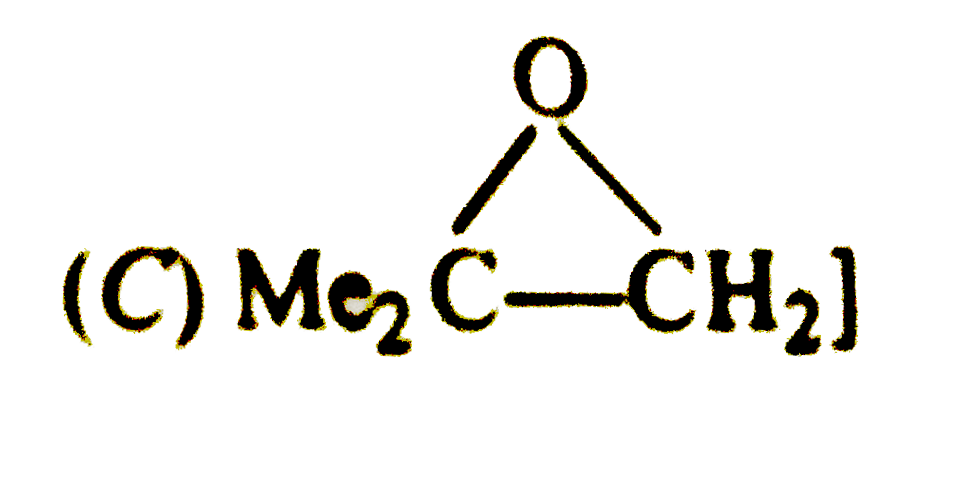(A) Find the product (A) and (B) in the given reaction
The correct Answer is:A
To solve the question, we need to identify the reactants and products in the given reactions. Let's break it down step by step.
Step 1: Identify Product A
The reaction starts with a compound A that reacts with alcoholic KOH. Alcoholic KOH is known to facilitate elimination reactions, leading to the formation of alkenes.
Given the options, we need to determine which compound can yield the alkene CH3-CH=CH2 upon treatment with alcoholic KOH.
1. Option A: CH3-CHBr-CH3
- When treated with alcoholic KOH, bromine (Br) is eliminated along with a hydrogen atom from the adjacent carbon, resulting in CH3-CH=CH2.
- This matches our desired alkene.
2. Option B: CH3-CH-CH2Br
- Similarly, treating this compound with alcoholic KOH will also lead to the formation of CH3-CH=CH2 through elimination.
Both options A and B can yield the same alkene, CH3-CH=CH2.
Step 2: Identify Product B
Next, we need to determine the product B formed when the alkene CH3-CH=CH2 is treated with HBr in the presence of peroxide.
According to the anti-Markovnikov rule, the addition of HBr in the presence of peroxide results in the hydrogen atom attaching to the carbon with fewer hydrogen atoms (the terminal carbon), while the bromine attaches to the carbon with more hydrogen atoms.
- The alkene CH3-CH=CH2 will react as follows:
- H will add to the first carbon (CH2) and Br will add to the second carbon (CH).
Thus, the product B is CH3-CH2-CH2Br.
Conclusion
- Product A: CH3-CHBr-CH3 (or CH3-CH-CH2Br)
- Product B: CH3-CH2-CH2Br
Final Answer
- Product A is CH3-CHBr-CH3 (or CH3-CH-CH2Br).
- Product B is CH3-CH2-CH2Br.
The reaction starts with a compound A that reacts with alcoholic KOH. Alcoholic KOH is known to facilitate elimination reactions, leading to the formation of alkenes.
- When treated with alcoholic KOH, bromine (Br) is eliminated along with a hydrogen atom from the adjacent carbon, resulting in CH3-CH=CH2.
- This matches our desired alkene.
- Similarly, treating this compound with alcoholic KOH will also lead to the formation of CH3-CH=CH2 through elimination.
Next, we need to determine the product B formed when the alkene CH3-CH=CH2 is treated with HBr in the presence of peroxide.
- H will add to the first carbon (CH2) and Br will add to the second carbon (CH).
Thus, the product B is CH3-CH2-CH2Br.
- Product A: CH3-CHBr-CH3 (or CH3-CH-CH2Br)
- Product B: CH3-CH2-CH2Br
- Product A is CH3-CHBr-CH3 (or CH3-CH-CH2Br).
- Product B is CH3-CH2-CH2Br.
Topper's Solved these Questions
- HYDROCARBONSBOOK - AAKASH INSTITUTE ENGLISHCHAPTER - HYDROCARBONSEXERCISE - SECTION-B OBJECTIVE TYPE QUESTIONS (ONE OPTION IS CORRECT)
25 Videos
- HYDROCARBONSBOOK - AAKASH INSTITUTE ENGLISHCHAPTER - HYDROCARBONSEXERCISE - SECTION-C OBJECTIVE TYPE QUESTIONS (MORE THAN ONE OPTIONS ARE CORRECT)
12 Videos
- HYDROCARBONSBOOK - AAKASH INSTITUTE ENGLISHCHAPTER - HYDROCARBONSEXERCISE - ADDITIONAL INFORMATION
3 Videos
- HALOALKANES AND HALOARENES BOOK - AAKASH INSTITUTE ENGLISHCHAPTER - HALOALKANES AND HALOARENES EXERCISE - ASSIGNMENT SECTION -D
15 Videos
- HYDROGENBOOK - AAKASH INSTITUTE ENGLISHCHAPTER - HYDROGENEXERCISE - ASSIGNMENT (SECTION - D) (Assertion-Reason Type question)
15 Videos
Similar Questions
Knowledge Check
Supply structural formulae for missing compounds.
(i) H2C=CH2+(A)→ClCH2−CH2OHH2SO4−−−−−−→413K(B)alc. KOH−−−−−−−→Δ(C)
(ii) CH3CHBrCH3alc. KOH−−−−→(A)HBr−−−−−→Peroxide(B)CH3ONa−−−−−→(C)
(iii) Me3CBralc. KOH−−−−→(A)HOCl−−−→(B)NaOH−−−→(C)
 AABCCH3CH=CH2CH3CH(Br)CH2BrCH3CH(OH)CH3BABCCH3CH=CH2CH3CH2CH2BrCH3CH2OCH2CH2CABCCH2CH=CH3CH3CH(Br)CH3CH3CH2OCH2CH2DABCCH2CH=CH3CH3CH2CH2BrCH2CH2CH2OCH3
AABCCH3CH=CH2CH3CH(Br)CH2BrCH3CH(OH)CH3BABCCH3CH=CH2CH3CH2CH2BrCH3CH2OCH2CH2CABCCH2CH=CH3CH3CH(Br)CH3CH3CH2OCH2CH2DABCCH2CH=CH3CH3CH2CH2BrCH2CH2CH2OCH3CH3−CH3∣CH−C≡CHexcess HBr−−−−−→
The product of the above reaction is :ACH3−CH3∣CH−Br∣CH−Br∣CH2BCH3−CH3∣CH−Br∣C=CH2CCH3−CH3∣CH−Br∣C∣Br−CH3DCH3−CH3∣CH−CH2−Br∣CH∣Br
CH3−CH2CH3∣CHCH=CHCH3H3O+−−−→
find the product of the reaction .
View Solution (i)CH3CHO−−−−−−−→(ii)H3O+ (A) HBr−−→ (B)
(i)CH3CHO−−−−−−−→(ii)H3O+ (A) HBr−−→ (B)
The compounds (A) and (B)
View SolutionThe relative reactivity of 1∘:2∘:3∘H's to brominate is 1:82:1600, respectively. In the reaction
CH3−CH3∣CHExcessCH3+Br2hv−−→CH3CH3∣C∣Br(A)CH3+CH3CH3∣C(B)HCH2Br
the percentage yield of the products (A) and (B) are expected to be
View Solution(a) Write the structural formula of A, B, C and D in the following sequence of reaction :
CH3−CI∣CH−CH3alc−−→KOHAHBr−−−−→PeroxideBNal−−−−→dry etherCMg−−−−→dry etherD
Illustrate Sandmeyer's reaction with the help of a suitable example.
View SolutionCH3−CH=CH2HBr−−−−→Peroxide[A]KOH(aq)−−−−−−→[B]H2SO4(conc.)−−−−−−−−−→443K[C]
View SolutionCH3−C∣CH3=CH2HBr−−−−→PeroxideCH3−CH∣CH3−CH2Br reaction intermediate of this reaction is:
View Solution
